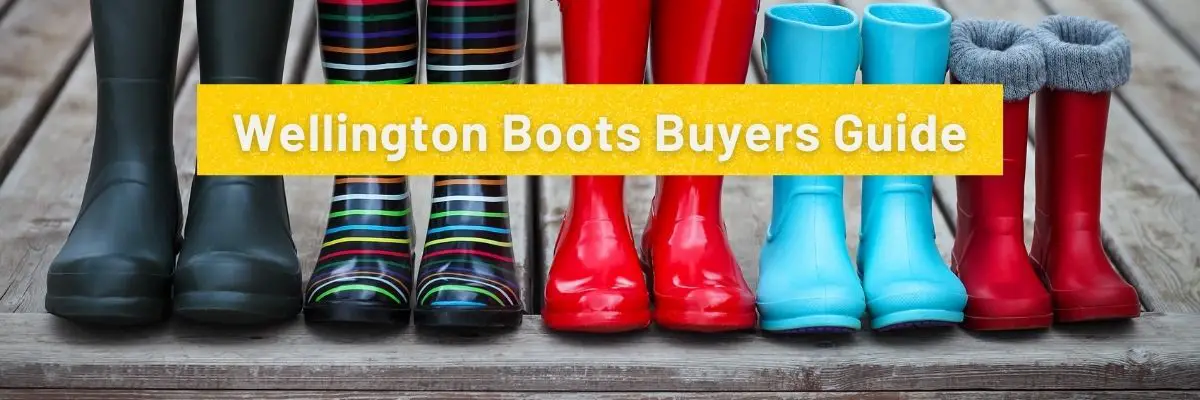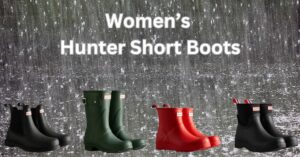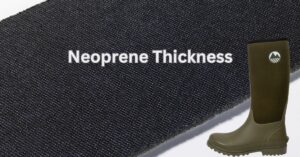Wellington Boots Buyers Guide
Everything you need to know about buying wellington boots
Buyers Guide Table of Content
It can be difficult to buy wellington boots online. There are so many different brands and styles, so it’s hard to know which ones to choose. So, we’ve put together this ultimate guide with our own tips on how to find the perfect pair of wellies!

Reasons For Buying Wellington Boots
Not so long ago it was easy to buy wellington boots, because they were pretty much all the same. They were green or black rubber boots that kept your feet dry in wet weather. But today, wellington boots have moved on to be so much more. Some come with insulation to keep feet warm in the coldest of weather. They can be tall, short or something in between. Some wellington boots have been specially designed for walking long distances. Other wellies are a fashion accessory. How many people have you seen walking down the street in brightly coloured \ patterned wellington boots? They’ve become something that are worn all year round, not just for rainy days.
Below is a list of occasions when wellington boots are often worn. For each of the occasions there are some considerations to help you buy the perfect wellie boots.
Gardening – What to think about when buying wellies for gardening
Wellington boots for gardening should ideally be made from natural rubber or cheaper PVC (plastic). This is because the boots need to protect feet against thorns and other sharp objects. Boots made from a soft material, like neoprene, won’t prevent thorns, brambles etc penetrating through the boots.
Another important consideration when buying wellies for gardening, is their flexibility. Both the sole and the gusset of the boots should have plenty of flexibility. This important, as often when gardening you will be bending or crouching and you don’t what the boots giving resistance.
Also consider the height of the boots. Should they be tall or short. Short boots generally work well for someone who only does a bit of light gardening every now and then. But, if you are going to spend quite a bit of time gardening then it is probably worth going for a quality pair of natural rubber tall boots, which will be flexible and provide support and protection.
Dog Walking – Buying boots for dog walking
If you’re after some new wellington boots to take the dog for a walk, then there are few things to to think about.
If you own a highly active dog like a Spaniel, you will probably be going on quite long walks on a regular basis. So, its worth buying wellies that have been specially designed for walking. If on the other hand you have a small house dog, walks are going to be much shorter. In which case you might only need some short ankle wellies that you can quickly pop on to let the dog out in the garden.
Farmers and Yard Work – What makes good wellies for farmers
If you’re a farmer or doing yard work, then you’ll probably be wearing boots for long periods of time, performing a lot of different tasks. Meaning that comfort and quality are going to be more important than how the wellington boots look.
It might make sense to get boots that provide added protection, such as steel toe caps. As dropping a heavy item on standard rubber wellie is going to hurt, a lot. Look for brands like Muck Boots and Grubs that have a selection of good quality safety boots.
Shooting – Considerations when buying shooting wellington boots
Shooting often involves either a lot of walking or a lot of standing. If you’re going to be standing a lot it is a good idea to look for wellington boots with insulation. As the lack of movement will mean feet feel the cold, especially if shooting at night or in cold weather, an insulated wellington boot is a must have.
If you walk a lot when shooting then it would make sense to choose boots that are made from natural rubber, rather than PVC. Natural rubber wellington boots are more flexible and will allow you to walk greater distances without discomfort. However, this flexibility does come at a price as natural rubber wellies tend to be significantly more expensive than PVC ones.
Popular brands used by people who shoot, include Aigle and Le Chameau.
Festivals – What to look for when buying wellies for festivals
When buying wellies for festivals, people often make the mistake of going for the cheapest and most colourful wellies they can find. Usually because they intend to chuck the boots after the festival……not very environmentally friendly. At most festivals there is going to be a lot of walking and dancing. Cheap wellies are usually made from PVC and don’t have much in the way of support or cushioning. This can lead to rubbing and sore feet after only a few hours of wearing them. Think of your festival wellies as an investment that you can use after the festivals and for future festivals
If your budget allows go for wellies that are made from natural rubber. Natural rubber boots are much more comfortable than cheaper PVC boots. Rubber boots are also available in many different colours and patterns, so you can still look good.
Fishing – How to choose the best wellington boots for fishing
Many anglers will walk long distances when fishing, helping them find the best spots on rivers and lakes. This means they need a good pair of wellington boots that are suitable for walking.
There can be a considerable amount of standing around, both in and beside the water, which can mean cold feet. Especially in the water which can rapidly make feet feel very cold, very quickly. Getting insulated wellies is a must. Ideally look at buying boots that have a neoprene lining.
Another consideration when choosing wellies for fishing is the sole of the boots. Go for boots with a think sole, this will help insulate feet from cold surfaces. The sole should also have decent grips to prevent slipping and falling.
Fashion – Buying stylish wellington boots
One important consideration when buying fashionable wellies, is that they are usually not of the same quality as ‘working’ boots. The boots will probably only last a few years, even with light use and don’t expect them to offer much in the way of comfort.
Probably the most popular and famous fashion wellington boots are Hunters Original boots which celebrities are often seen wearing.
Hiking \ Long Walks – Wellies made for walking
Another important factor when buying wellies for walking is the tread. The tread on a wellies should be deep and evenly spaced to provide good grip in all types of weather conditions, from wet grass to icy pavements.
When looking for wellies for hiking or long walks, try and get a pair with a calf strap. This will stop the boots from flapping against your legs as you walk, ensuring greater comfort and stability.

How Much Should You Pay For Wellington Boots
The short answer is that there really isn’t a right price for wellington boots, because everyone’s budget and requirements will be different. It’s possible to buy reasonable quality short, mid-height or tall wellington boots for £30 to £60. If you want one of the top brands then expect to pay at least £100 plus.
Any boots under £30 would be considered cheap. But, just because they’re cheap doesn’t mean that they aren’t right for you. For example, parents will often buy cheap kids wellies, because kids feet grow fast. There’s no point in buying expensive wellies if you are only going to use them a few times a year, like going to a festival.
When it comes to buying wellies, like most things, you get what you pay for. Paying £300 for a pair of Le Chameau Vierzonord might seem a lot of money for a pair of wellington boots, but you will be getting very high quality, super comfortable boots that will last for years, probably decades. If you are ever in a shop that sells expensive wellington boots, it is worth trying them on. You will be surprised at just how good they are!
In the long run the more expensive boots will probably work out more cost effective than buying cheap wellies.
As general guide, spend as much as you can afford.

How To Decide Which Height Wellies To Buy
Wellie boots typically come in three different heights, tall, mid-height and short \ ankle boots. If you want to get the best out of your wellies you will want to make sure you buy the correct height boots.
Note, that some manufactures refer to mid-height boots as short boots. In this article short wellies are ankle height boots.
Below are some of the pros and cons of each of the different wellington boot heights.
Advantages of tall wellington boots
They are better for keeping warm
This isn’t just because they cover more of you leg. Most manufacturers only produce tall insulated wellies. It is possible to find mid-height and short boots that have insulation, but they are few and far between and often it is only the sole that is insulated.
They are best for wet conditions
Tall boots go higher up the leg so they offer more protection form the wet e.g. deep puddles, long grass etc. Also, many tall boots have a buckle or some type of fastener at the top that can be tightened to prevent water going into the boots. This can be especially useful in a heavy down pour, preventing rain dripping in to the boots.
Best for walking
This might surprise most people, as it doesn’t seem logical that a boot with a tall shaft is going to be comfortable when walking. However, when you look at reviews online you will see that all the best boots for walking are tall boots. Tall boots that have been designed for walking won’t flap about on your legs and the foot area will be firm and flexible. Many walking wellies also have a degree of ‘breathability’ to prevent feet from getting sweaty.
Disadvantages of tall wellington boots
Difficult to put on and take off
Sometimes the long gusset and a slightly narrower ankle area can make it difficult to put tall boots on and take the off. This isn’t true for all tall boots. Many boots have some type of adjustment on the gusset that can be loosened to make it easier to put the boots on. Also, boots designed for wide calves are wider around the ankle, which makes it easier to put boots on \ take off.
Less flexibility
This is particularly true of tall boots that are made from PVC, rather than natural rubber. PVC is a very tough material, but one of the downsides is that it has no flexibility. This can be a problem for tall boots, making them uncomfortable to wear.
Advantages of mid-height wellington boots
Easy to put and take off
The gusset on mid-height boots is low enough to make it easy to put the boots on and take them off. For most mid-height boots you won’t need the help of a shoe horn to put the boots on or a boot jack to take them off.
Suitable for wide calves
In many cases mid-height wellington boots won’t come as high as the widest part of the calf. This makes them a good choice for people who have wider calves. If you have extremely wide calves. a short boot \ ankle boots might be a better option.
Disadvantages of Mid-height wellington boots
Flap when walking
Unlike tall boots, mid-height boots don’t usually come with any sort of adjustment at the top of the boot. This can mean when walking the top part of the boots continually hits the shin area. This usually isn’t too much of a problem if you’re only walking short distances, however it can become very annoying on long walks.
Limited choice
If you’re in the market to buy mid-height boots you will probably be disappointed by the limited choices available compared to short wellies and tall wellies. All the big brand wellington boots manufacturers do have ranges of mid-height wellington boots.
Advantages of short wellington boots
Cheaper
The vast majority of short boots are designed as simple waterproof boots. There are very few short boots that target the high end of the market. For example, not many have an insulated lining. Some come with an insole that has a fleece or faux fur lining, but not the entire inside of the boots
Good for Wide Calves
One of he big benefits of short boots is that they are suitable for people with wide calves. Short boots only come as high as the ankle, well below the calves. So, if you’ve been struggling to find some tall wellies that fit wide claves, then short wellies might be a good option.
Disadvantages of short wellington boots
Limited Protection
Waterproof Clogs \ Gardening Clogs
Recently waterproof clogs have become very popular, especially among women. Waterproof clogs are usually made from rubber and are backless or have a very low cut. The main advantage is that they are easy to put on and take off. In fact you can just slip them on, without using your hands. Think of them like outdoor slippers.
Most of the big wellington boots brands, such as Hunter, Aigle etc have a line of waterproof clogs

Best Wellington Boot Lining
In this section we will cover all of the different types of linings that are available. Discovering what the benefits and disadvantages of each of the linings and what situations they are best suited.
Textile lining
The vast majority of boots have a textile lining. A textile lining simply means that there is thin cloth lining. Textile linings are usually made from cotton, polyester or a combination of the two.
A textile lining has the following benefits
- It makes putting the boots on and taking them off easier. If there was no lining, rubber boots would be very difficult to put, due to the high degree of friction caused by the rubber
- The textile lining absorbs moisture (wicking) that can build up in the boots, usually due to sweat. This makes the boots much more comfortable to wear
The disadvantage of textile lining
- A textile lining provides very little in the way of insulation. Wellington boots with a textile line are not suitable for the cold
Neoprene lining
A neoprene lining is a type of insulation made from a synthetic rubber material that is similar to the kind used in wetsuits. It traps air inside its cells to create an insulating layer.
Advantages of a neoprene lining:
- The best thing about a neoprene lining is it will keep feet warm, in the coldest of conditions. The thicker the neoprene lining the better the insulation. The thickness of the neoprene varies from 3mm up to 8mm
- The other big benefit of having a neoprene lining is that it provides greater comfort. The spongey nature of the neoprene provides shock absorption and snug fit.
Disadvantages of a neoprene lining
- Neoprene lined boots are designed for cold conditions, this can mean that in warmer conditions feet get too hot. Neoprene is not breathable, which means that heat can build-up. It should be noted that some manufacturers have their own version of neoprene that is breathable.
- Neoprene boots are usually tighter fitting than other types of boots, which some people find claustrophobic.
- Neoprene doesn’t come cheap, which means that neoprene lined wellies have a higher costs
Leather Lining
Leather is a great natural material that is sometimes used as a wellington boots lining. Only boots at the top end of the market have a leather lining.
Advantages of leather lined wellies
- Leather lining keeps feet warm in the winter and cool in the summer.
- Leather lined wellie boots are comfortable. This is partly because boots made from leather are more expensive and so more design effort has gone into them, but also leather is a great natural material for foot wear.
Disadvantages of having leather lined wellies
- Leather lined wellies are considered luxurious and so cost considerably more that other types of wellington boots.
- Leather is a great hard wearing natural material, but only if it is looked after. Leather lined boots do require a bit more care than other boot linings
Gore-tex lining
Gore-tex is a man made lining that is waterproof, but also breathable. Wellington boots with a Gore-tex lining are not made from rubber or PVC, as these are not breathable materials and so the Gore-tex won’t work. Instead Gore-tex is usually used with leather boots
Advantages of Gore-tex lined boots
- Gore-tex is both waterproof and breathable. This means it prevents water from penetrating the boots and at the same time allows moisture (sweat) in the boots to escape. This ultimately leads to greater comfort.
Disadvantages of Gore-tex lined boots
- Gore-tex lining is quite thin and it only takes a small hole or rip to make the material ineffective
- Gore-tex has not been designed to insulate from the cold.
Bamboo carbon lining
Wellington boots bamboo carbon lining is a type of thin insulation that is made from bamboo charcoal. A natural material that is known for its thermal properties. This is a relatively new type of lining and not currently widely used.
Advantages of bamboo carbon lining
- Bamboo carbon linings are a popular choice among wellington boot buyers because they help to keep your feet warm in cold weather conditions and cool in hot weather.
- Bamboo carbon is also effective at wicking moisture away from your skin, which can help to prevent blisters and other foot problems.
Disadvantages of bamboo carbon lined wellies
- The lining is not suitable for extreme temperature. If you want a warm wellie in sub-zero temperatures, then go for a neoprene lining.
Fur lining
Many boots are advertised as being fur lined, but in fact they are faux-fur, which is a synthetic pile fabric designed to have the appearance and properties of animal fur. Wellington boots can be fully lined with faux-fur or just the insole is faux-fur lined
Advantages of a fur lining
- Faux-fur is a great insulator and will help keep feet warm in cold conditions. Not as good as neoprene at keeping feet warm.
- Boots with a fur lining feel super soft and cosy to wear, especially if the boot is fully lined with fur.
Disadvantages of a fur lining
- Overtime the fur becomes compacted, reducing its insulating properties.
- Fur lined boots can become smelly and dirty, requiring them to be cleaned. To help prevent this, it is a good idea to wear socks with fur lined boots.
There are a number of other different materials used by wellington boot manufacturers, but they are not very common. For example, Ugg produce boots with an insole lining made from wool.

Wellington Boots Sizing Guide
Should you go a size bigger in wellies
There is a common believe that you should buy wellies a size larger than your normal shoe size. This is incorrect. You should buy wellington boots that are the same size as your normal shoes size.
There are a couple exceptions:
- Most wellie boots are not available in half sizes. If your normal shoe size is a half size, then go up in size, rather than down. The difference between a half size and a full size is very small, about 3mm
- Sometimes manufacturers do make boots that are slightly larger or smaller than expected. It is always a good idea to read feedback from customer reviews to determine if the boots are correctly sized.
Can you buy wellies in half sizes
The vast majority of wellington boots are not available in UK or US half sizes. However some of the European manufactured boots are produced to EU shoe sizes which are actually the same as a UK or UK half size.
What to look for when buying wellie boots for wide calves
Finding the right pair of tall wellies to fit wide calves can be a problem for many people. Fortunately, most of the big brands, like Hunter, Aigle, Joules and Muck have recognised this problem and produce a range of tall wellington boots that have been specially designed for wide calves.
Adjustable buckle
Many boots have an adjustable buckle at the top of the gusset. However, not all buckles are the same! Many boots have a buckle that serves no purpose other than aesthetic. When buying boots with a buckle make sure that the buckle is actually adjusting the width of the boot.
wellington boots have an adjustable buckle either on the top rear of the boots of at the top on the side. It is really down to personal preference as to where the buckle is located. It doesn’t appear to make a difference as to how well the boots fit wide calves
Wellies designed for wide calves
As mentioned, many of the main stream wellie manufacturers make tall wellie boots that have been specially designed for wide calves. These boots can easily be identified as they will be appropriately named. For example Hunter usually have ‘wide leg’ or ‘wide fit’ in the product name.
There are also boot brand that specialise in making wide boots. Probably the most famous is Jileon, who make a great range of wide wellington boots. They (probably) make the widest wellington boots that you can buy, up to 23″ \ 58cm
Short \ ankle wellies
To avoid any issues with boots being to tight around the calf area, is to buy wellies that are only ankle height. This isn’t an option for everyone, as there are a few downsides to short ankle wellies (see earlier in article) and obviously if you want tall wellies this isn’t an option.







